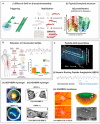Glycosaminoglycan-Inspired Biomaterials for the Development of Bioactive Hydrogel Networks
- PMID: 32098281
- PMCID: PMC7070556
- DOI: 10.3390/molecules25040978
Glycosaminoglycan-Inspired Biomaterials for the Development of Bioactive Hydrogel Networks
Abstract
Glycosaminoglycans (GAG) are long, linear polysaccharides that display a wide range of relevant biological roles. Particularly, in the extracellular matrix (ECM) GAG specifically interact with other biological molecules, such as growth factors, protecting them from proteolysis or inhibiting factors. Additionally, ECM GAG are partially responsible for the mechanical stability of tissues due to their capacity to retain high amounts of water, enabling hydration of the ECM and rendering it resistant to compressive forces. In this review, the use of GAG for developing hydrogel networks with improved biological activity and/or mechanical properties is discussed. Greater focus is given to strategies involving the production of hydrogels that are composed of GAG alone or in combination with other materials. Additionally, approaches used to introduce GAG-inspired features in biomaterials of different sources will also be presented.
Keywords: GAG; GAG-mimetics; biomaterials; hybrid systems; hydrogels; polysaccharides; proteins; self-assembly peptides.
Conflict of interest statement
The authors declare no conflict of interest.
Figures











Similar articles
-
Intact vitreous humor as a potential extracellular matrix hydrogel for cartilage tissue engineering applications.Acta Biomater. 2019 Feb;85:117-130. doi: 10.1016/j.actbio.2018.12.022. Epub 2018 Dec 18. Acta Biomater. 2019. PMID: 30572166
-
The composition of hydrogels for cartilage tissue engineering can influence glycosaminoglycan profile.Eur Cell Mater. 2010 Feb 26;19:86-95. doi: 10.22203/ecm.v019a09. Eur Cell Mater. 2010. PMID: 20186668
-
Glycosaminoglycan-Based Biohybrid Hydrogels: A Sweet and Smart Choice for Multifunctional Biomaterials.Adv Mater. 2016 Oct;28(40):8861-8891. doi: 10.1002/adma.201601908. Epub 2016 Jul 27. Adv Mater. 2016. PMID: 27461855 Free PMC article. Review.
-
Extracellular matrix particle-glycosaminoglycan composite hydrogels for regenerative medicine applications.J Biomed Mater Res A. 2018 Jan;106(1):147-159. doi: 10.1002/jbm.a.36218. Epub 2017 Sep 26. J Biomed Mater Res A. 2018. PMID: 28879659
-
Chemically modified glycosaminoglycan derivatives as building blocks for biomaterial coatings and hydrogels.Biol Chem. 2021 May 18;402(11):1385-1395. doi: 10.1515/hsz-2021-0171. Print 2021 Oct 26. Biol Chem. 2021. PMID: 34008374 Review.
Cited by
-
Metabolic engineering of Escherichia coli for enhanced production of hyaluronic acid.Biotechnol Lett. 2025 Mar 14;47(2):34. doi: 10.1007/s10529-025-03578-4. Biotechnol Lett. 2025. PMID: 40085269
-
Hyaluronic Acid-Modified Luteolin-Copper Complex Nanodelivery System for Bacterial Prostatitis.ACS Omega. 2024 Oct 6;9(41):42582-42592. doi: 10.1021/acsomega.4c07724. eCollection 2024 Oct 15. ACS Omega. 2024. PMID: 39431109 Free PMC article.
-
Sustained delivery of 17β-estradiol by human amniotic extracellular matrix (HAECM) scaffold integrated with PLGA microspheres for endometrium regeneration.Drug Deliv. 2020 Dec;27(1):1165-1175. doi: 10.1080/10717544.2020.1801891. Drug Deliv. 2020. PMID: 32755258 Free PMC article.
-
Upcycling Eggshell Matrix for Sustainable Production of Glycosaminoglycans.Biopolymers. 2025 Sep;116(5):e70040. doi: 10.1002/bip.70040. Biopolymers. 2025. PMID: 40690197 Free PMC article. Review.
-
Macromolecular crowding and decellularization method increase the growth factor binding potential of cell-secreted extracellular matrices.Front Bioeng Biotechnol. 2023 Jan 23;11:1091157. doi: 10.3389/fbioe.2023.1091157. eCollection 2023. Front Bioeng Biotechnol. 2023. PMID: 36756385 Free PMC article.
References
Publication types
MeSH terms
Substances
Grants and funding
- POCI-01-0145-FEDER-028744/FEDER - Fundo Europeu de Desenvolvimento Regional
- PTDC/BTMMAT/28744/2017/FCT - Fundação para a Ciência e a Tecnologia
- SFRH/BD/129855/2017/FCT - Fundação para a Ciência e a Tecnologia
- IF/00296/2015/FCT - Fundação para a Ciência e a Tecnologia
- POCI-01-0145-FEDER-032431/FEDER - Fundo Europeu de Desenvolvimento Regional
LinkOut - more resources
Full Text Sources

